“Please do not spoil, transform or improve them out of existence”
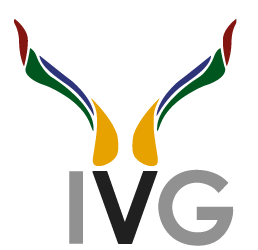
Indigenous Veld Goats
IVG aim to encourage interest and educate people on
the breeding & profitability of Indigenous Veld Goats
The Indigenous Veld Goat (IVG)
The Veld Goat is indigenous to southern Africa. It almost disappeared with the purifying of the Boer Goat.
Over centuries the Veld Goat survived a long and dangerous migration journey through Africa and its genes are to a marked extent, developed by natural selection.
These goats have developed naturally towards functional efficiency;
- they move with ease and can walk long distances;
- they are antelope like with longer legs; cow hocks and sickle hocks can occur;
- they can either graze or browse on a wide variety of plants, shrubs and grasses.
They are highly fertile even from a young age, have a long breeding season and produce offspring the year through, and have a long productive lifespan. The Veld Goat ewes are known for their remarkable mothering abilities and fierce protection of their offspring.
The Veld Goat is indigenous to southern Africa. It almost disappeared wi
They have a wide variety of colours and colour patterns – due to this, they are difficult to spot by predators.
They have excellent herding instinct to help protect themselves from predators, and will even fight them off with their sharp horns.
Due to their hard brown hooves, there is almost no sign of growing claws.
They are highly tick and parasite tolerant.
Naturally polled goats may occur occasionally.
Their meat is succulent with good flavour and very low in cholesterol.
Man had almost no say in the development of the Indigenous Veld Goat and it must stay that way.
The basis for every breeder’s selection should be natural, unimproved, unchanged, functional animals.
Quick identification Reference
Indigenous Veld Goat Eco Types
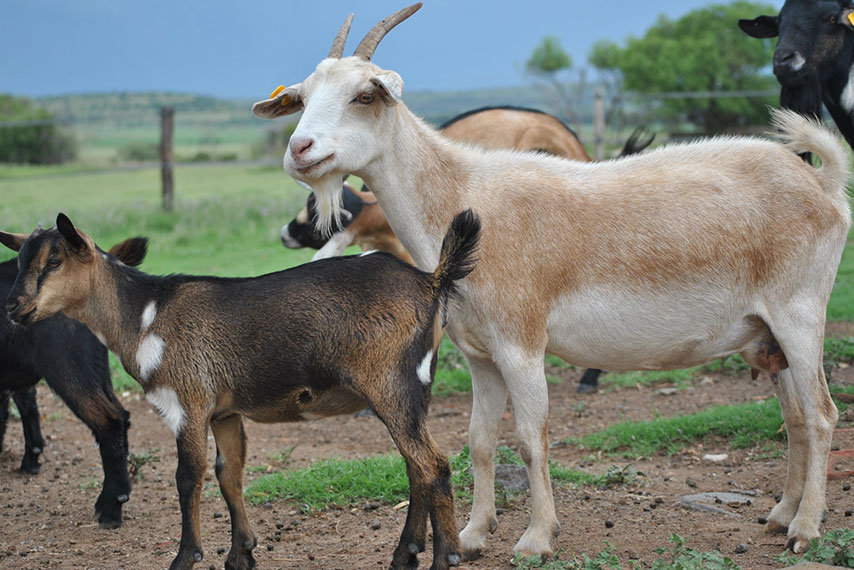
NGUNI TYPE (MBUZI’S)
The Nguni type is probably the group that occurs more abundantly than the other distinct types of indigenous goats, in Southern Africa.
They occur specifically in the higher rainfall area stretching from the Ciskei, Transkei, Kwa-Zulu Natal, Swaziland, Mpumalanga, Northern Province, Botswana, the Caprivi, and extreme northern, high rainfall area of Namibia.
BODY
Small Frame, Compact, Well Proportioned
LEG
Strong, Fine, Medium to long
COLOUR
Multi-coloured, uniform colours, pied, dappled, speckled. Tendency for Swiss Markings
HEAD & PROFILE
Concaved (Hollow) to flat
EARS
Small to medium, semi pendulous lateral (sidelong and outwards) slightly forward
HORNS
Upwards and outwards with many variations
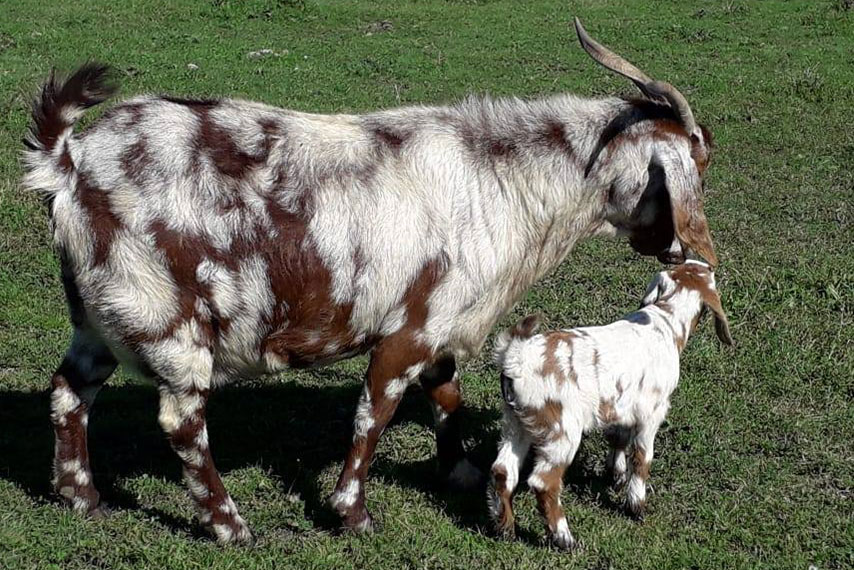
CAPE LOB EARS
As this type of goat was found in the regions that the Koi (hottentots) settled it can be assumed that they migrated down the drier west coast, this is born out of the respiratory frame type and droopy lob ears from which they obtained their name.
Dr P Lombaard and other officials of the Irene Animal Production Institute started a project to collect indigenous Xhosa goats of the Ciskei, when it became apparent that they were in danger of being completely eliminated by the development of the Boer Goat. With the help of Mr Jim Hundlebee a limited number of the goats were obtained from 1988 to 1991 and transferred to Loskop South Research Station. Only a handful of breeders in South Africa preserved some of these original multicoloured, lob eared goats
BODY
Large Frame, Robust, Well muscled
LEG
Strong, Medium to long
COLOUR
Multi-coloured, uniform colours, dappled marble & flowery patterns, even speckled.
HEAD & PROFILE
Flat to slightly convexed (Bulging) rather long and strong.
EARS
Lobed, Large and droopy
HORNS
Large upwards and outwards, inclined to be larger than the skull
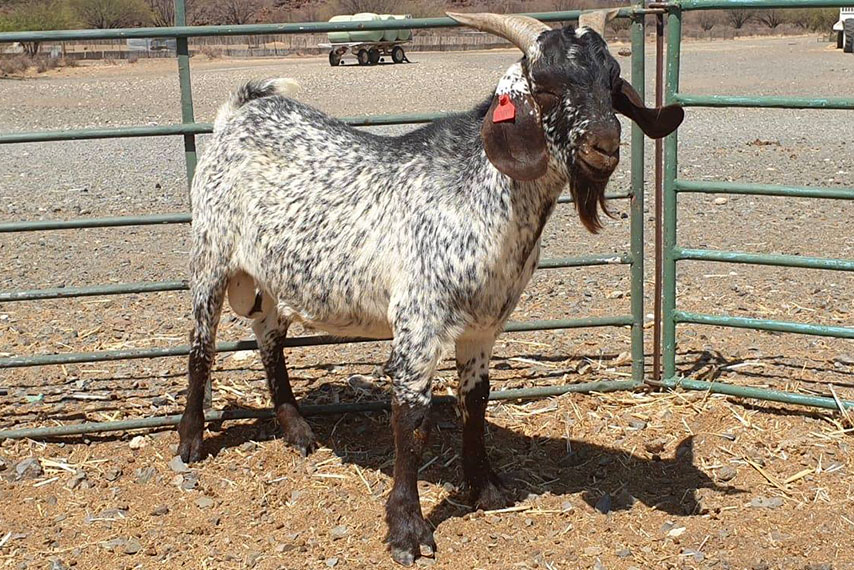
CAPE SPECKLED
the region that the Koi (hottentots) settled. The migration route would be
the same as the Cape Lobear. However as pointed out by Barrow (1801),
presumably tribal custom and other factors through selection they became
a unique eco-type of their own differing slightly from the Cape Lobear in
phenotype.
The Speckled Goat has its origin in the dry Northern Cape, Karoo area, stretching from Sutherland to Upington. Barrow (1801) wrote that near the
Hartbees river in the Northern Cape he encountered some “Namaqua Hottentots (Khoisan) who possessed a herd of small handsome goats that were
spotted like the leopard.”
The Speckled Goat (previously known as Northern Cape Speckled Goat) went with pioneer farmers to Namibia, around World War 1 and the “Dorslandtrek” during the previous century. Here some Namibian farmers preserved them and kept them pure. Over time breeders in South Africa bought them from these farmers, and brought them back to various parts of South Africa.
BODY
Large frame, Well muscled
LEG
Strong, Medium to long, Colours are concentrated to almost solid
COLOUR
White body with red-brown or black sports. Concentrations of spots vary.
HEAD & PROFILE
Convexed to flat, rather long with slight dip in front of the eyes
EARS
Lobed, Large and droopy
HORNS
Upwards and outwards with tips curving in, more or less the same length as the skull
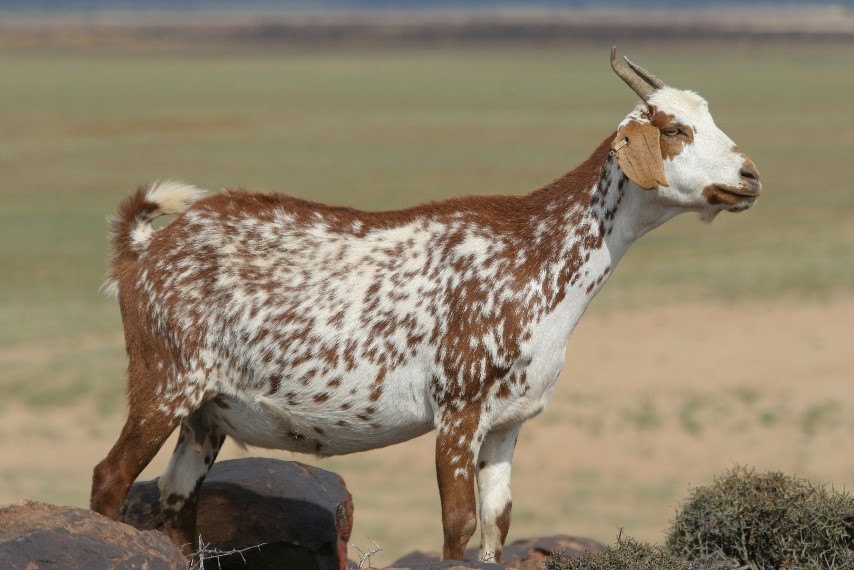
KUNENE TYPE KOAKOLAND
The Himba people live a semi-transhumance lifestyle, moving with their animals to where grazing is available.
BODY
Medium frame, Slender.
LEG
Finely boned, Lanky, Exellent walkers.
COLOUR
Multi-colours, uniform colours, two toned, pied, speckled and dappled.
HEAD & PROFILE
Flat to slightly convexed, Narrow face.
EARS
Lobed, Long and droopy. Usually more narrow than other eco-types.
HORNS
Slightly up and a little outwards, usually length of head and in line with profile. Base is closely spaced
Agriculture
Dr Laurie Hammond (1995) director of the U.N. Food and Agricultural Organization, stated that 40% of the world’s 4000 domestic livestock breeds are in danger of becoming extinct. The worldwide trend for super breeds could be wiping out thousands of indigenous breeds with their unique abilities to perform in harsh environments. Hammond (op.cit.) continued: “Breeds of cattle, pigs and poultry, once the backbone of farming economics in many countries, were being replaced by a few super breeds which only performed in ideal conditions. Irreplaceable genetic resources are being lost. Many of these native breeds have maintained humans for more than 10 000 years.
Their loss is not just a matter of heritage. It’s very much about our future.”
Links
GRASSFED ASSOCIATION OF SOUTH AFRICA
The GrassFed Association of SA is the governing body for Grass Fed and Free Range meat from ruminants including goat, lamb/mutton, beef and venison.


